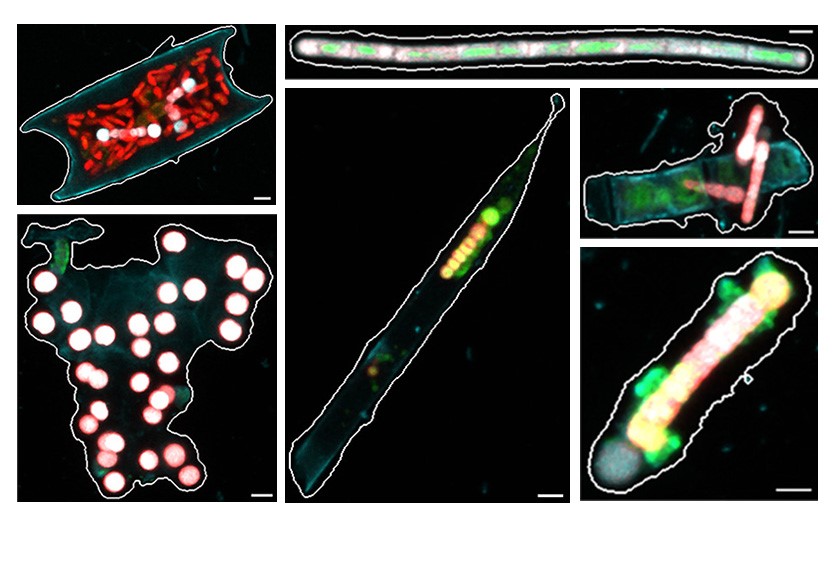Although great attention is currently given to carbon, notably because of the role of CO₂ in climate change, nitrogen too deserves a spotlight in life sciences. Like carbon, nitrogen is a primary component of living organisms (it is present in DNA, proteins, etc.). It is also one of the main factors limiting the growth of land plants and phytoplankton (microscopic aquatic organisms responsible for close to half of the photosynthesis occurring on earth). That seems counterintuitive, knowing that nitrogen constitutes close to 80% of the earth's atmosphere. However, that content is in the form of dinitrogen (N₂), a diatomic molecule that is very stable and resistant to chemical reactions. Consequently, living organisms have great difficulty assimilating it. This is why the limited but very diverse group of microbes called diazotrophs is crucial for the earth's ecosystem. These microorganisms perform a chemical process called nitrogen fixation, wherein they capture environmental N₂ and convert it into molecules useful for other organisms. They are, figuratively speaking, earth's fertilizers.
The diazotrophs comprise several groups of bacteria and archaea. On land, more than 90% of nitrogen fixation is done by diazotrophic bacteria living symbiotically with various types of plants. Numerous land environments are well-described in this setting because of their vital agricultural importance. However, the nitrogen fixation occurring in the oceans is at least as important as that occurring on land. In terms of size, marine diazotrophs cover more than three orders of magnitude (from micrometers to millimeters), particularly because of their different modes of life: isolated cells, colony-forming cells or symbiotic cells. That aspect complicates sampling and the ability to separate diazotrophs from other, often much more abundant microbial communities (excepting certain localized and seasonal proliferations of diazotrophs). Furthermore, the simple vastness of the earth's oceans complicates the observation and study of their diversity, distribution and activities. "This is where Tara Oceans, a project to sample marine planktonic communities at an unprecedented level across the world's oceans, enters the game," comments Chris Bowler, CNRS researcher at the Institute of Biology of the Ecole Normale Supérieure (IBENS) in Paris and co-author of the recent study published in Nature Communications on the worldwide distribution of diazotrophs.
In the 38 months between its launch in September 2009 and its return to port in December 2013, the scientific schooner Tara sailed for more than 140,000 kilometers across the earth's principal ocean regions, systematically collecting both environmental parameters and samples of micron-to-millimeter-sized planktonic species in more than 200 different locations. At all of those locations, DNA contents were determined from samples taken at the surface and at several depths (200 and 100 meters). Furthermore, at some of the locations, collections of microscopic images were established. In the Nature Communications article, Juan Pierella Karlusich and his colleagues in France (ENS, CEA, Paris-Saclay University, Sorbonne University), Germany (EMBL), Spain (CSIC) and Sweden (Stockholm University) used machine learning prediction tools to assess more than 2 million images, and paired that with analyses of more than 30 tara-base-pairs of DNA sequence data to provide a better global vision of the abundance, diversity and distribution of marine diazotrophs.
Eric Pelletier, a study co-author from Genoscope (CEA-Jacob), underlines that "this is one of the first large-scale studies to combine omics (information on genomes) and imaging (form, size, aspect) data on non-cultured microorganisms; it signals a new era in environmental studies."
Rachel Forster, a co-author from Stockholm University adds that she "was truly surprised to observe how much the images predicted the genes, and the genes the images. Planktonic organisms are dispersed, and sampling a specific lot is difficult. The high-throughput imaging datasets were essential for the study. We acquired great biogeochemical knowledge on the ecology of these important populations. Also, our approach can be adapted to numerous other communities."
One of the study's most important findings was the existence of previously undetected diazotroph "hotspots" in ocean regions theretofore poorly explored, and its most unexpected the discovery of "ultrasmall" diazotrophs measuring less than 0.2 µm. According to the article's first author, "the study's detection of novel highly active regions and new diazotrophic organisms will advance knowledge in this field of study."
The study furthermore acts as a proof of concept, showing that the integrated analysis of molecular and imaging data can provide more precise information on marine microorganisms. Because nitrogen is a key element in planktonic dynamics and, consequently, in biogeochemical cycles and the climate, this international study furnishes important information for understanding the global ecosystem and how anthropogenic changes may affect it.

Source : Ecotaxa
Figure : Multichannel confocal microscopy images of diverse forms of marine diazotrophic cyanobacteria. Clockwise from top-left: symbiosis between Richelia and a Hemiaulus diatom, Trichodesmium free filament, Calothrix–Chaetoceros (diatom) symbiosis, Richelia free filament, Richelia–Rhizosolenia (diatom) symbiosis, colony of cyanobacteria.
CONTACTS :
Juan José Pierella Karlusich
(CNRS/INSERM/ENS)
pierella@biologie.ens.fr
Eric Pelletier
(CNRS/UNIV EVRY-VAL-D'ESSONNE/CEA)
Chris Bowler
(CNRS/INSERM/ENS)
Rachel Foster